Design and Validation of 100 nm GaN-On-Si Ka-Band LNA Based on Custom Noise and Small Signal Models
Abstract
1. Introduction
2. Chosen Technology
2.1. Description
2.2. Modelling
3. Test Vehicle Design
4. Layout and Performance
5. Conclusions
Author Contributions
Funding
Conflicts of Interest
Abbreviations
| DC | Direct current |
| EM | Electromagnetic |
| GaAs | Gallium arsenide |
| GaN | Gallium nitride |
| HEMT | High electron mobility transistor |
| HPA | High power amplifier |
| IC | Integrated circuit |
| IMN | Input matching network |
| ISMN | Inter-stage matching network |
| LNA | Low-noise amplifier |
| LRRM | Line reflect reflect match |
| MIM | Metal-insulator-metal |
| MMIC | Microwave monolithic integrated circuit |
| NF | Noise figure |
| NFmin | Minimum noise figure |
| OIP3 | Output third harmonic intercept point |
| O1 dBcp | Output 1 dB compression point |
| RF | RadioFrequency |
| SCFE | Single-chip front-end |
| Si | Silicon |
| SiC | Silicon carbide |
| SOLT | Short open line thru |
| SPDT | Single-pole double-throw |
| TRM | Transmit-receive module |
| VNA | Vector Network analyzer |
References
- Leuther, A.; Tessmann, A.; Dammann, M.; Massler, H.; Schlechtweg, M.; Ambacher, O. 35 nm mHEMT Technology for THz and ultra low noise applications. In Proceedings of the 2013 International Conference on Indium Phosphide and Related Materials (IPRM), Kobe, Japan, 19–23 May 2013; Volume 2, pp. 1–2. [Google Scholar] [CrossRef]
- Komiak, J.J.; Smith, P.M.; Duh, K.H.G.; Xu, D.; Chao, P.C. Metamorphic HEMT technology for microwave, millimeter-wave, and submillimeter-wave applications. In Proceedings of the Technical Digest—IEEE Compound Semiconductor Integrated Circuit Symposium (CSIC), Monterey, CA, USA, 13–16 October 2013; pp. 1–4. [Google Scholar] [CrossRef]
- Ciccognani, W.; Colangeli, S.; Longhi, P.E.; Limiti, E. Design of a MMIC low-noise amplifier in industrial gallium arsenide technology for E-band 5G transceivers. Microw. Opt. Technol. Lett. 2019, 61, 205–210. [Google Scholar] [CrossRef]
- Ciccognani, W.; Longhi, P.E.; Colangeli, S.; Limiti, E. Q/V band LNA for satellite on-board space applications using a 70 nanometers GaAs mHEMT commercial technology. Microw. Opt. Technol. Lett. 2018, 60, 2185–2190. [Google Scholar] [CrossRef]
- Longhi, P.E.; Pace, L.; Colangeli, S.; Ciccognani, W.; Limiti, E. Technologies, Design, and Applications of Low-Noise Amplifiers at Millimetre-Wave: State-of-the-Art and Perspectives. Electronics 2019, 8, 1222. [Google Scholar] [CrossRef]
- Giordani, R.; Amici, M.; Barigelli, A.; Conti, F.; Del Marro, M.; Feudale, M.; Imparato, M.; Suriani, A. Highly integrated and solderless LTCC based C-band T/R module. In Proceedings of the European Microwave Week 2009, EuMW 2009: Science, Progress and Quality at Radiofrequencies, Conference Proceedings—39th European Microwave Conference (EuMC), Rome, Italy, 28–29 September 2009; pp. 1760–1763. [Google Scholar] [CrossRef]
- Ciccognani, W.; Colangeli, S.; Serino, A.; Pace, L.; Longhi, P.E.; Limiti, E.; Poulain, J.; Leblanc, R. Comparative noise investigation of high-performance GaAs and GaN millimeter-wave monolithic technologies. In Proceedings of the 14th European Microwave Integrated Circuits Conference (EuMIC), Paris, France, 29 September–2 October 2019; pp. 1–4. [Google Scholar]
- Sarazin, N.; Morvan, E.; Di Forte Poisson, M.A.; Oualli, M.; Gaquiere, C.; Jardel, O.; Drisse, O.; Tordjman, M.; Magis, M.; Delage, S.L. AlInN/AlN/GaN HEMT technology on SiC with 10-W/mm and 50% PAE at 10 GHz. IEEE Electron Device Lett. 2010, 31, 11–13. [Google Scholar] [CrossRef]
- Sun, H.; Alt, A.R.; Benedickter, H.; Feltin, E.; Carlin, J.F.; Gonschorek, M.; Grandjean, N.; Bolognesi, C.R. Low-noise microwave performance of 0.1 µm gate AlInN/GaN HEMTs on SiC. IEEE Microw. Wirel. Components Lett. 2010, 20, 453–455. [Google Scholar] [CrossRef]
- Palombini, D.; Rampazzo, D.; Bentini, A.; Longhi, P.E. Design of a 5W Single Chip Front-End for C-Ku Band T/R Modules. In Proceedings of the IEEE MTT-S International Microwave Symposium Digest, Philadelphia, PA, USA, 10–15 June 2018; pp. 647–650. [Google Scholar] [CrossRef]
- Limiti, E.; Colangeli, S.; Bentini, A.; Nanni, A. Characterization and modeling of low-cost, high-performance GaN-Si technology. In Proceedings of the 2012 19th International Conference on Microwaves, Radar and Wireless Communications, MIKON 2012, Warsaw, Poland, 21–23 May 2012; Volume 2, pp. 599–604. [Google Scholar] [CrossRef]
- Hilt, O.; Zhytnytska, R.; Böcker, J.; Bahat-Treidel, E.; Brunner, F.; Knauer, A.; Dieckerhoff, S.; Würfl, J. 70 mΩ/600 V normally-off GaN transistors on SiC and Si substrates. In Proceedings of the 2015 IEEE 27th International Symposium on Power Semiconductor Devices and IC’s (ISPSD), Hong Kong, China, 10–14 May 2015; Volume 2015, pp. 237–240. [Google Scholar] [CrossRef]
- De Padova, A.; Longhi, P.E.; Colangeli, S.; Ciccognani, W.; Limiti, E. Design of a GaN-on-Si Single-Balanced Resistive Mixer for Ka-band Satcom. IEEE Microwav. Wirel. Compon. Lett. 2019, 29, 56–58. [Google Scholar] [CrossRef]
- Pace, L.; Ciccognani, W.; Colangeli, S.; Longhi, P.E.; Limiti, E.; Leblanc, R. A Ka-Band Low-Noise Amplifier for Space Applications in a 100 nm GaN on Si technology. In Proceedings of the PRIME 2019 15th Conference on Ph.D. Research in Microelectronics and Electronics, Lausanne, Switzerland, 15–18 July 2019; pp. 161–164. [Google Scholar] [CrossRef]
- Reveyrand, T.; Ciccognani, W.; Ghione, G.; Jardel, O.; Limiti, E.; Serino, A.; Camarchia, V.; Cappelluti, F.; Quéré, R. GaN transistor characterization and modeling activities performed within the frame of the KorriGaN project. Int. J. Microw. Wirel. Technol. 2010, 2, 51–61. [Google Scholar] [CrossRef]
- Colangeli, S.; Longhi, P.E.; Ciccognani, W.; Limiti, E. On the Optimum Noise-Gain Locus of Two-Ports. IEEE Trans. Microw. Theory Tech. 2019, 67, 2284–2290. [Google Scholar] [CrossRef]
- Salvucci, A.; Longhi, P.E.; Colangeli, S.; Ciccognani, W.; Serino, A.; Limiti, E. A straightforward design technique for narrowband multi-stage low-noise amplifiers with I/O conjugate match. Int. J. Microw.-Comput.-Aided Eng. 2019, 29, e21833. [Google Scholar] [CrossRef]
- Nsele, S.D.; Robin, C.; Tartarin, J.G.; Escotte, L.; Piotrowicz, S.; Jardel, O.; Delage, S. Ka-band low noise amplifiers based on InAlN/GaN technologies. In Proceedings of the 2015 International Conference on Noise and Fluctuations, Xi’an, China, 2–6 June 2015; pp. 1–4. [Google Scholar] [CrossRef]
- Suijker, E.M.; Rodenburg, M.; Hoogland, J.A.; Van Heijningen, M.; Seelmann-Eggebert, M.; Quay, R.; Brückner, P.; Van Vliet, F.E. Robust AlGaN/GaN low noise amplifier MMICs for C-, Ku- and Ka-band space applications. In Proceedings of the Technical Digest—IEEE Compound Semiconductor Integrated Circuit Symposium, CSIC, Greensboro, NC, USA, 11–14 October 2009; pp. 3–6. [Google Scholar] [CrossRef]
- Rudolph, M.; Chaturvedi, N.; Hirche, K.; Würfl, J.; Heinrich, W.; Tränkle, G. Highly rugged 30 GHz GaN low-noise amplifiers. IEEE Microw. Wirel. Compon. Lett. 2009, 19, 251–253. [Google Scholar] [CrossRef]
- Micovic, M.; Brown, D.; Regan, D.; Wong, J.; Tai, J.; Kurdoghlian, A.; Herrault, F.; Tang, Y.; Burnham, S.D.; Fung, H.; et al. Ka-Band LNA MMIC’s Realized in Fmax > 580 GHz GaN HEMT Technology. In Proceedings of the Technical Digest—IEEE Compound Semiconductor Integrated Circuit Symposium, CSIC, Austin, TX, USA, 23–26 October 2016; pp. 1–4. [Google Scholar] [CrossRef]
- Fung, A.; Hoffman, J.; Aguirre, F.; Horst, S. Development of Gallium Nitride Monolithic Microwave Circuits for the Modular Dual-Band Ku/Ka Antenna Tile with Digital Calibration (K-Tile). Presentacion, 14–16 June 2016. [Google Scholar]
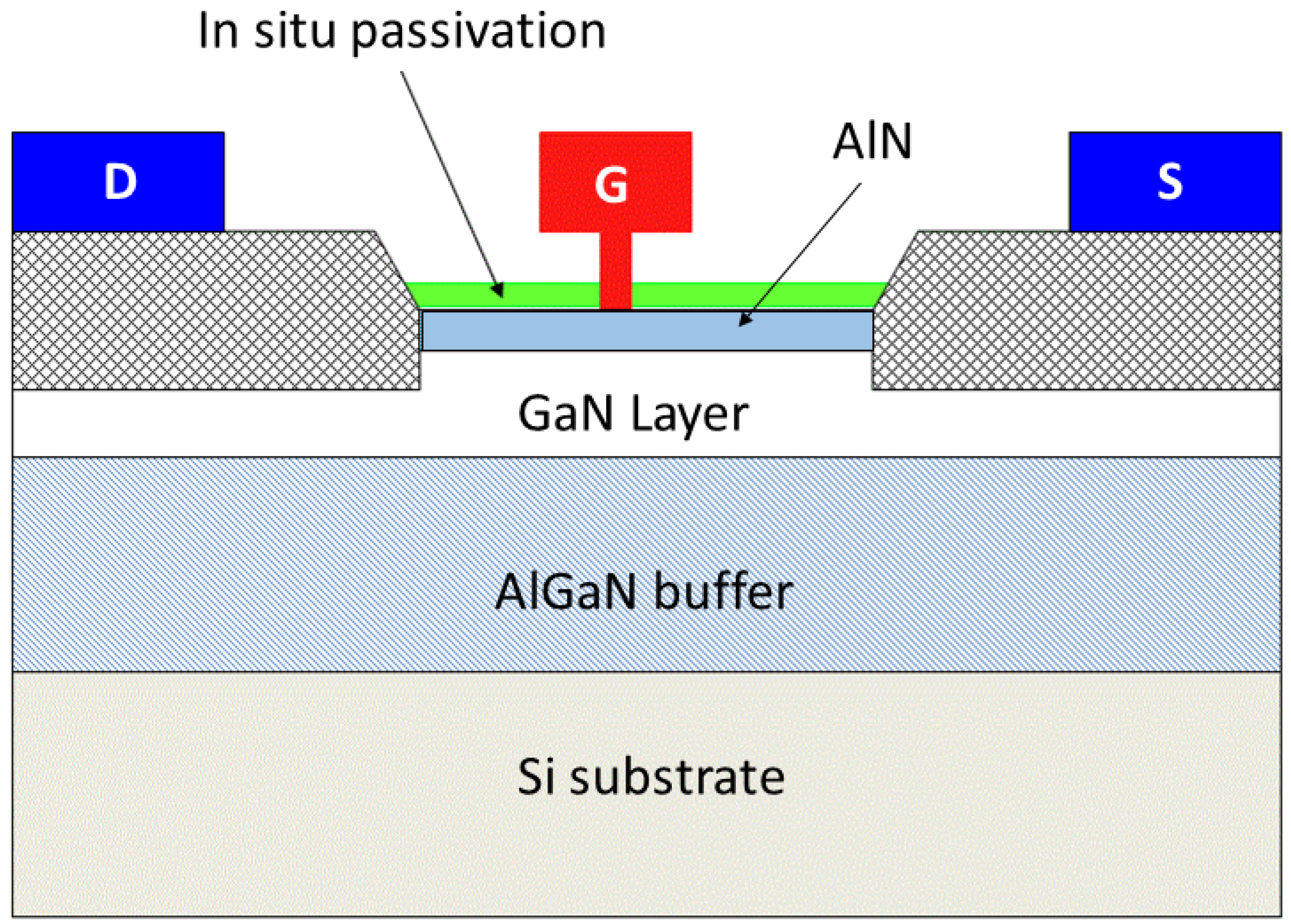
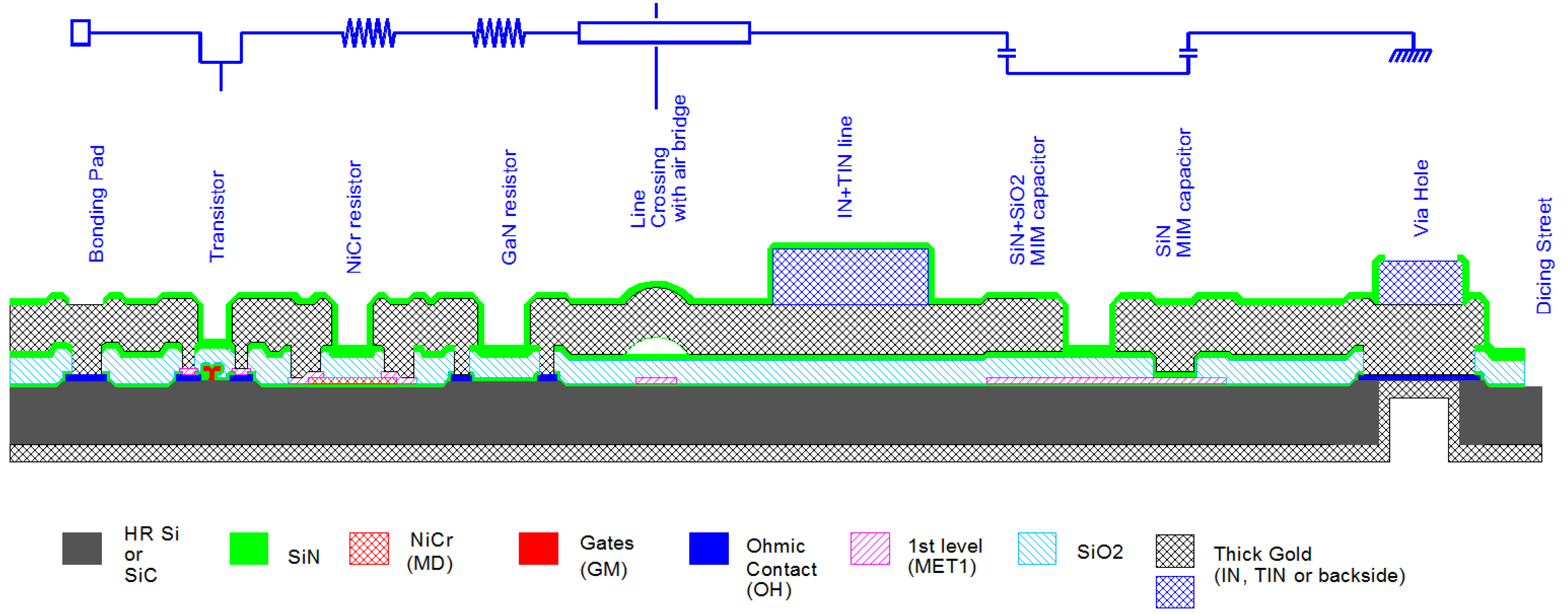
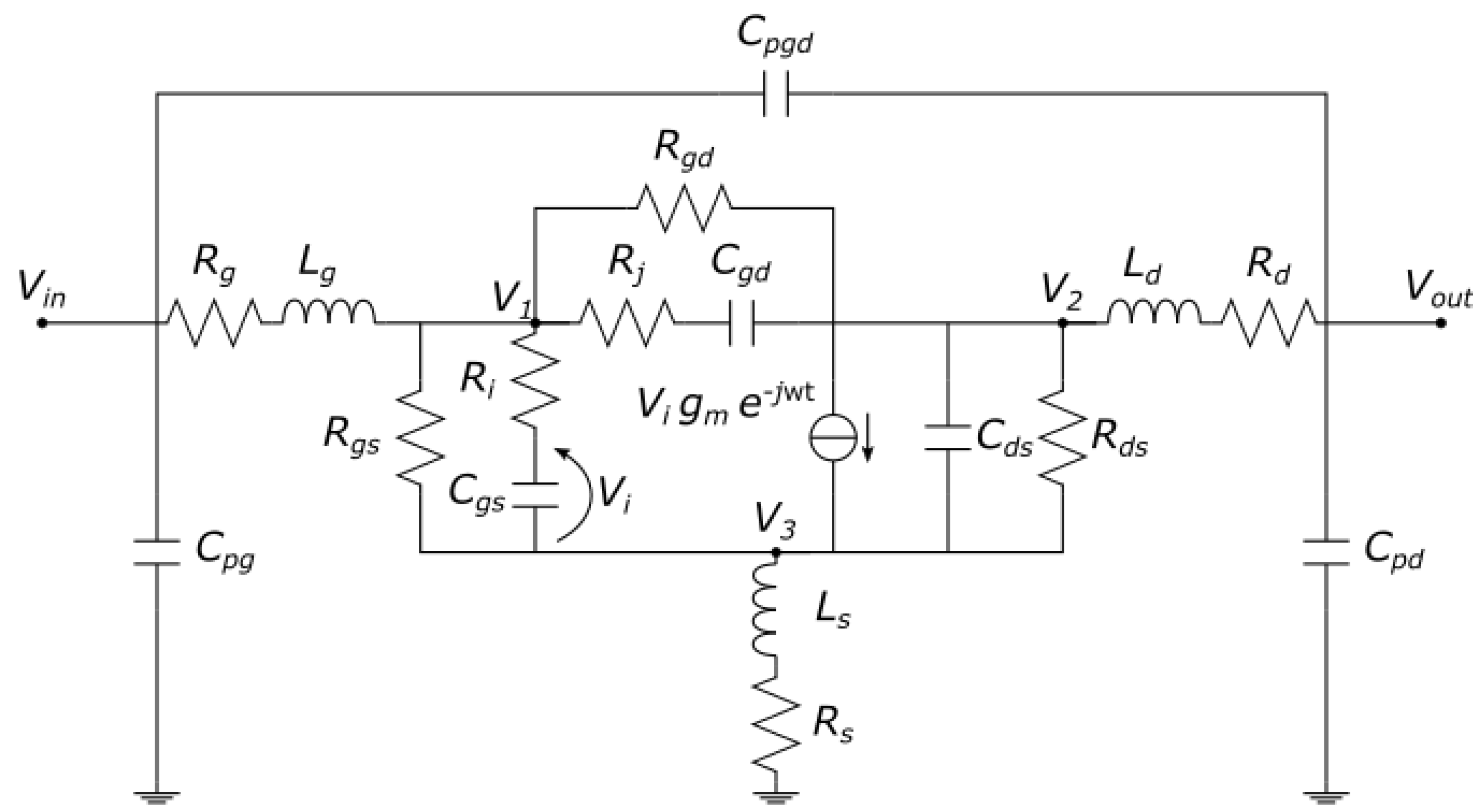
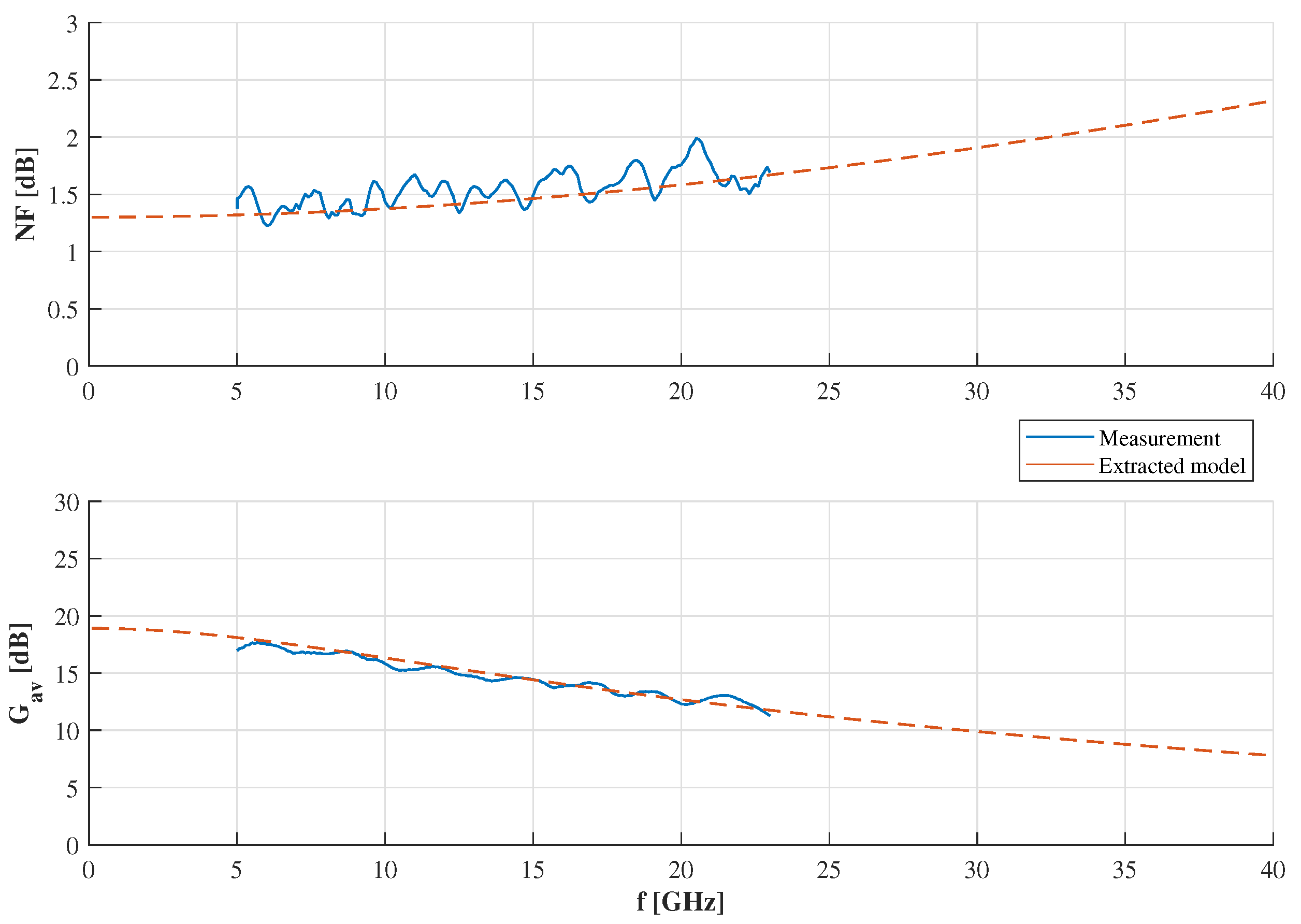
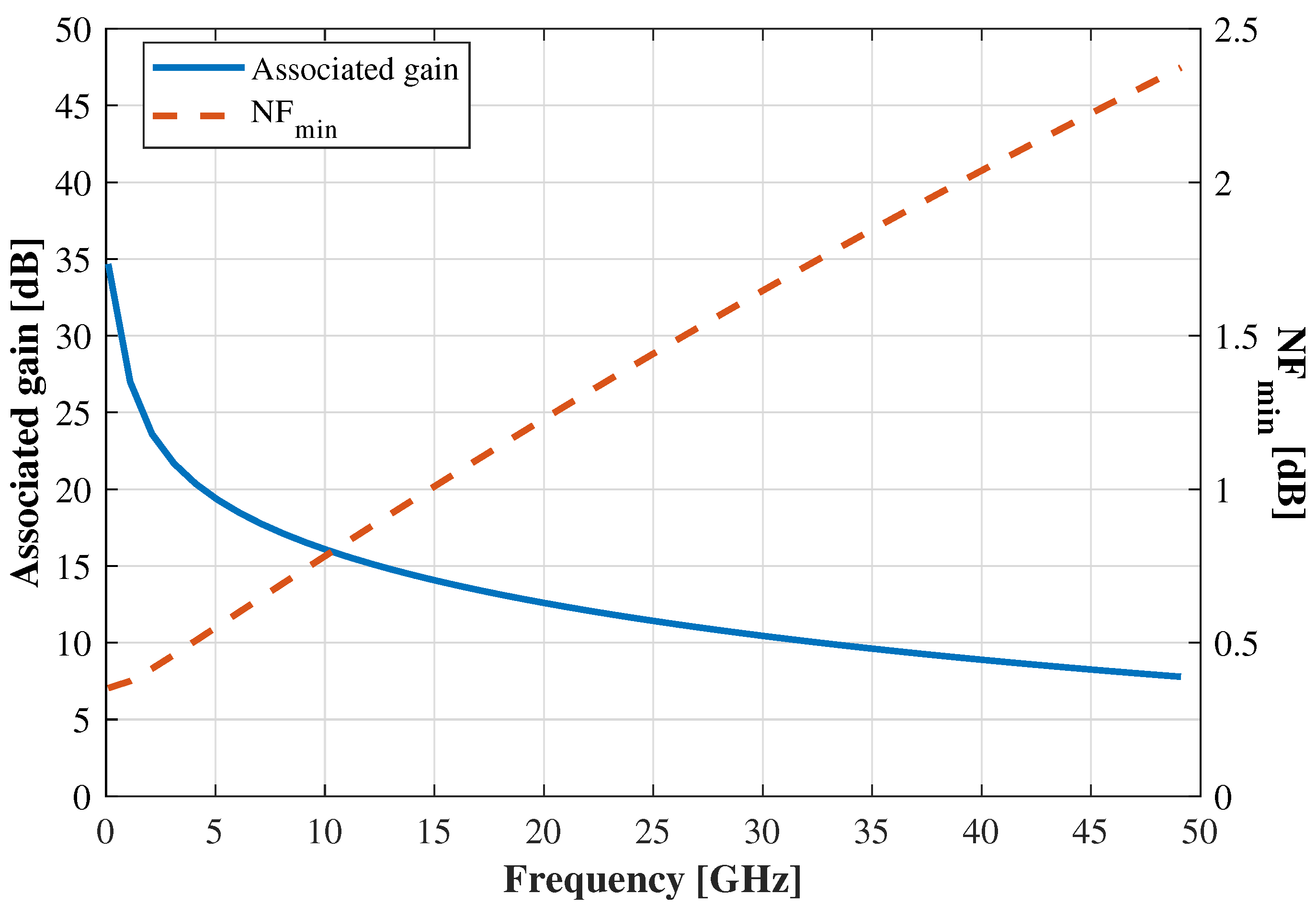
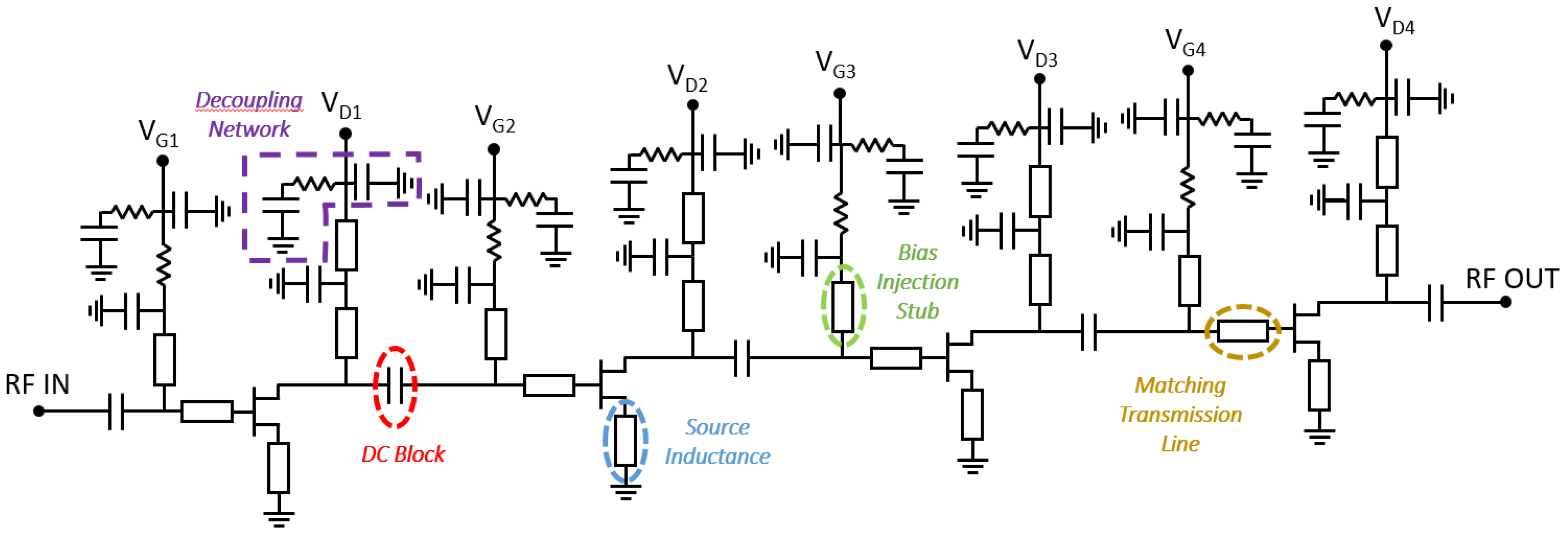

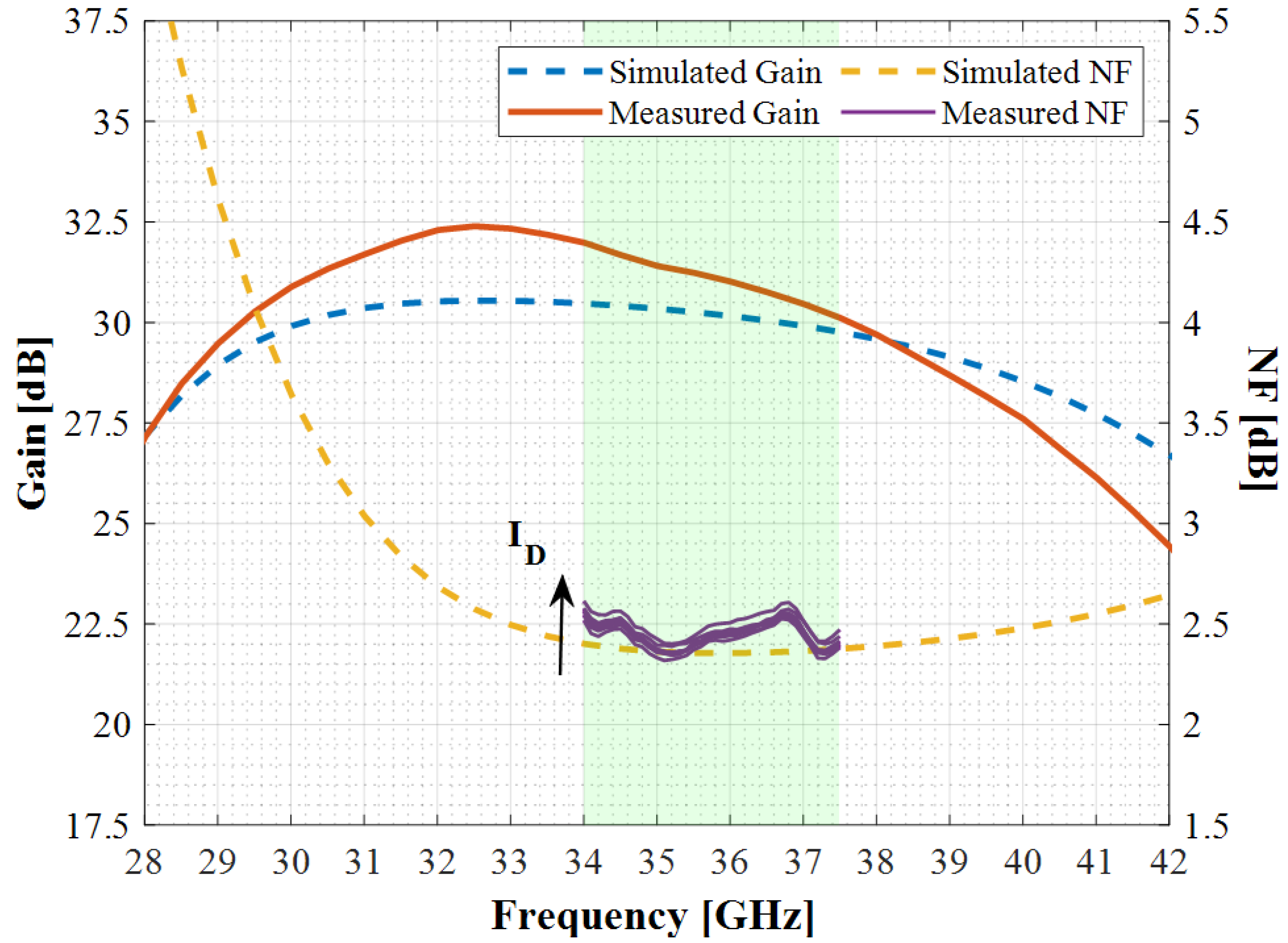
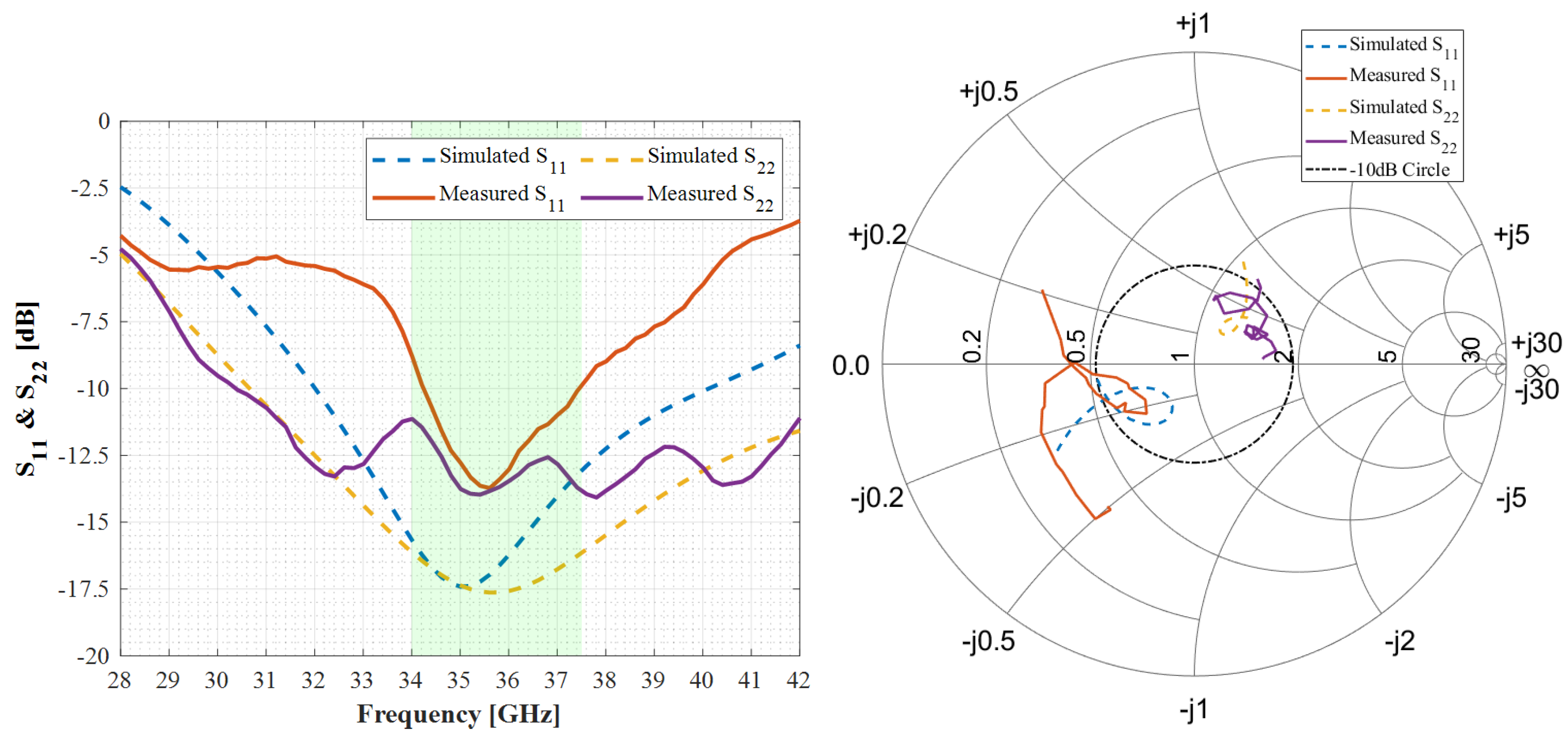
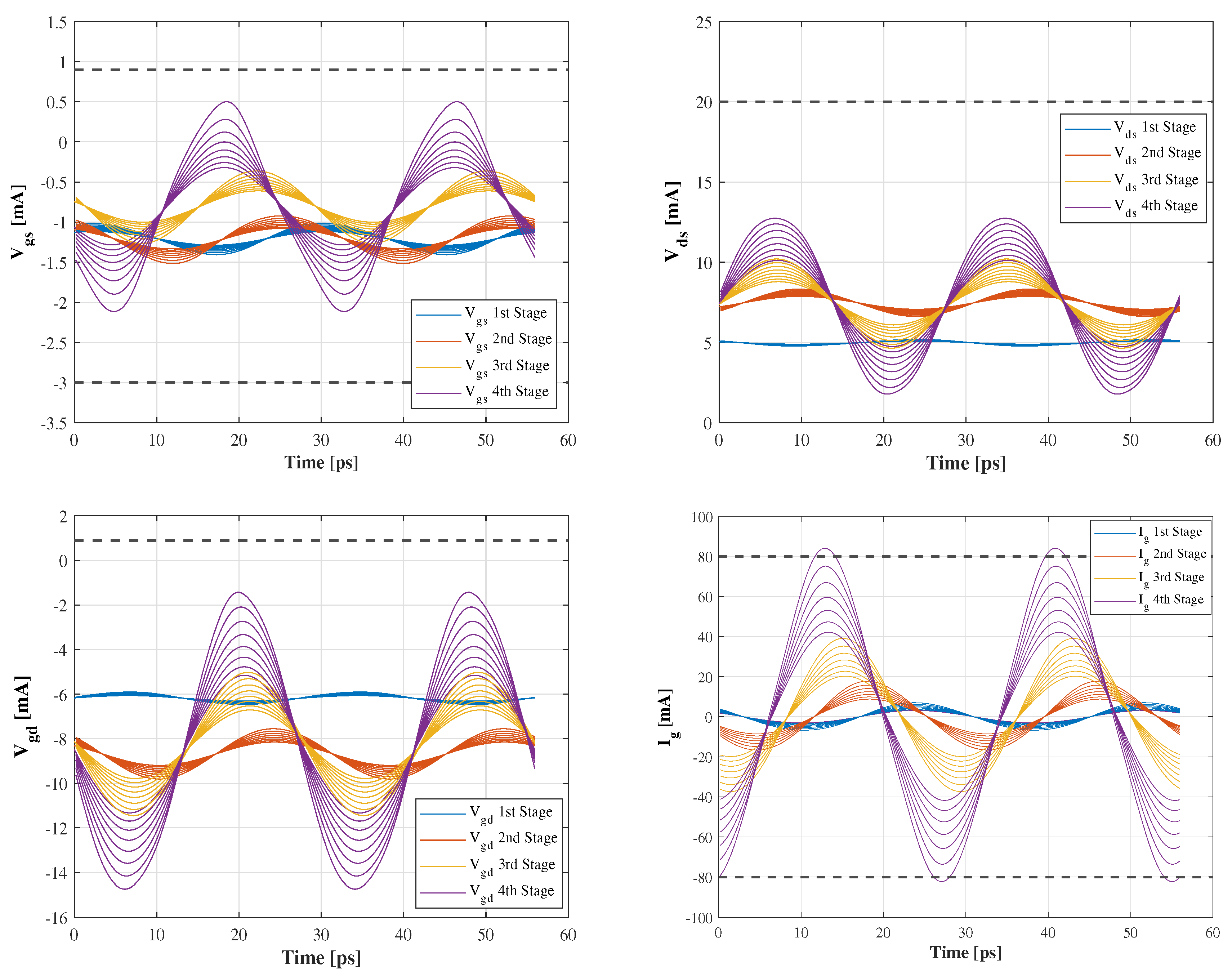
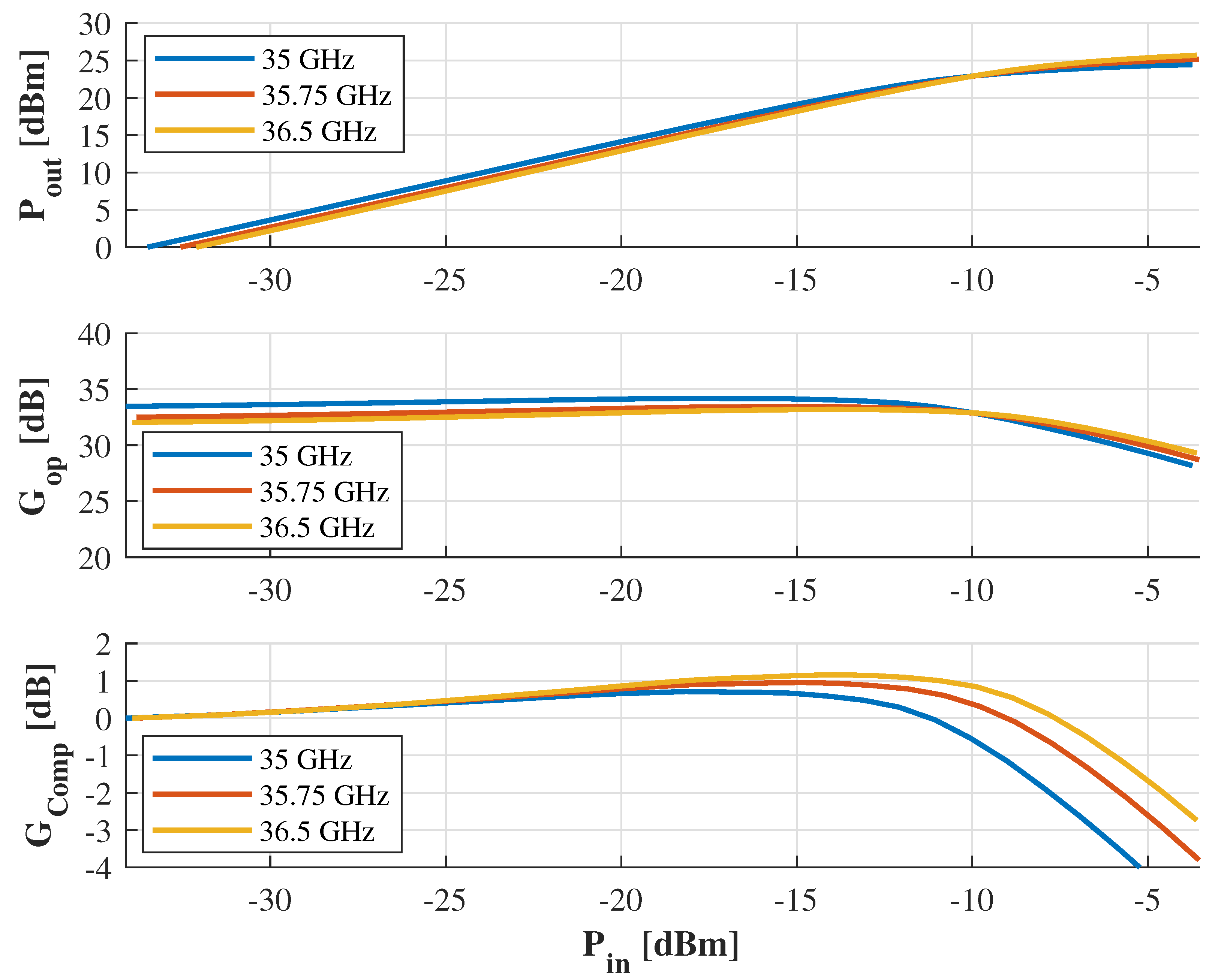
| Parameter | Unit | Value |
|---|---|---|
| Gate Length | nm | 100 |
| Substrate Thickness | µm | 100 |
| fT | GHz | 110 |
| fMAX | GHz | 160 |
| RF Power Density | W/mm | 3.3 |
| Transconductance | mS/mm | 800 |
| Noise Figure @ 40GHz | dB | 1.5 |
| IDss Max | A/mm | 1.7 |
| Breakdown VGD | V | 36 |
| VDD for best noise | V | 3 to 7 |
| VDD for power | V | 12 to 13 |
| Parameter | Unit | Value |
|---|---|---|
| Frequency | GHz | 34 to 37.5 |
| Linear Gain | dB | ≥30 |
| Noise Figure | dB | ≤2.5 |
| I/O Return Loss | dB | ≥10 |
| Output 1dBcp | dBm | ≥20 |
| Unit | 1st stg | 2nd stg | 3rd stg | 4th stg | |
|---|---|---|---|---|---|
| Periphery | µm | 4 × 35 | 4 × 35 | 4 × 35 | 4 × 35 |
| VDD | V | 5 | 7.5 | 7.5 | 7.5 |
| ID | mA | 16 | 25 | 69 | 69 |
| PDC | W | 0.08 | 0.18 | 0.52 | 0.52 |
| Parameter | Unit | Value |
|---|---|---|
| Vgd | V | −30 to +0.9 |
| Vgs | V | −3 to +0.9 |
| Vds | V | −20 to +20 |
| Ig | DC mA/finger | 2 |
| Ig | DC + RF mA/finger | 20 |
| Ka-Band GaN LNAs | Unit | [18] | [19] | [20] | [21] | [22] | This Work |
|---|---|---|---|---|---|---|---|
| Substrate | SiC | SiC | SiC | SiC | Si | Si | |
| Gate Length | [nm] | 150 | 150 | 150 | 40 | 150 | 100 |
| Frequency | [GHz] | 25 to 35 | 27.5 to 28.5 | 27 to 31 | 27 to 40 | 35.5 | 34 to 37.5 |
| Avg Gain | [dB] | ≥20 | 18 | ≤20 | ≤27 | 17 | 31 |
| Avg NF | [dB] | ≥3 | 4 | ≤3.9 | ≤1.6 | 2.9 | 2.4 |
| I/O Return Loss | [dB] | ≥10 | ≥6.5 | ≥7 | ≥5 | ≥9 | ≥10 |
| Output 1dBcp | [dBm] | - | ≥12.5 | - | 11 | - | 23 |
| PDC | [W] | 0.36 | 0.2 | - | 0.082 | 0.3 | 1.3 |
| O1dBcp/PDC | [%] | - | 8.9 | - | 15.3 | - | 19 |
| Size | [mm2] | 2.6 × 0.8 | 3 × 2 | 3.4 × 1.2 | 3.1 × 1.12 | - | 3.6 × 2 |
© 2020 by the authors. Licensee MDPI, Basel, Switzerland. This article is an open access article distributed under the terms and conditions of the Creative Commons Attribution (CC BY) license (http://creativecommons.org/licenses/by/4.0/).
Share and Cite
Pace, L.; Colangeli, S.; Ciccognani, W.; Longhi, P.E.; Limiti, E.; Leblanc, R.; Feudale, M.; Vitobello, F. Design and Validation of 100 nm GaN-On-Si Ka-Band LNA Based on Custom Noise and Small Signal Models. Electronics 2020, 9, 150. https://doi.org/10.3390/electronics9010150
Pace L, Colangeli S, Ciccognani W, Longhi PE, Limiti E, Leblanc R, Feudale M, Vitobello F. Design and Validation of 100 nm GaN-On-Si Ka-Band LNA Based on Custom Noise and Small Signal Models. Electronics. 2020; 9(1):150. https://doi.org/10.3390/electronics9010150
Chicago/Turabian StylePace, Lorenzo, Sergio Colangeli, Walter Ciccognani, Patrick Ettore Longhi, Ernesto Limiti, Remy Leblanc, Marziale Feudale, and Fabio Vitobello. 2020. "Design and Validation of 100 nm GaN-On-Si Ka-Band LNA Based on Custom Noise and Small Signal Models" Electronics 9, no. 1: 150. https://doi.org/10.3390/electronics9010150
APA StylePace, L., Colangeli, S., Ciccognani, W., Longhi, P. E., Limiti, E., Leblanc, R., Feudale, M., & Vitobello, F. (2020). Design and Validation of 100 nm GaN-On-Si Ka-Band LNA Based on Custom Noise and Small Signal Models. Electronics, 9(1), 150. https://doi.org/10.3390/electronics9010150








